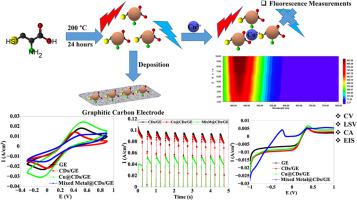Our official English website, www.x-mol.net, welcomes your feedback! (Note: you will need to create a separate account there.)
Heteroatoms-doped carbon dots as dual probes for heavy metal detection
Talanta ( IF 6.1 ) Pub Date : 2024-03-19 , DOI: 10.1016/j.talanta.2024.125893 Faisal K. Algethami , Hani Nasser Abdelhamid
Talanta ( IF 6.1 ) Pub Date : 2024-03-19 , DOI: 10.1016/j.talanta.2024.125893 Faisal K. Algethami , Hani Nasser Abdelhamid

|
The utilization of -cysteine in hydrothermal synthesis allows for the manufacture of carbon dots (CDs) that are doped with heteroatoms including oxygen, nitrogen, and sulfur (N, S, O-doped CDs). CDs have a particle size ranging from 1 to 3 nm, with an average particle size of 2.5 nm. N, S, and O-doped CDs display a blue fluorescence emission at a wavelength of 425 nm. It shows a reliance on the specific excitation wavelength between 320 and 500 nm. It has a selective quenching effect specifically with copper (Cu) ions when exposed to interactions with heavy metal ions, as compared to other metal ions. The assay has a limit of detection (LOD) of 2 μM and exhibits a linear correlation within the concentration range of 10–33.3 μM. The fluorescence mechanism was elucidated by employing various analytical techniques, such as transmission electron microscopy (TEM), high-resolution TEM , UV–Vis spectroscopy, zeta potential analysis, and conductometry. An analysis of the data reveals that Cu ions exhibit a strong attraction to the external surface of N, S, and O-doped CDs, leading to the formation of aggregates. N, S, and O-doped CDs can be also used as probes for electrochemical investigations utilizing cyclic voltammetry (CV), linear sweep voltammetry (LSV), chronoamperometry (CA), and electrochemical impedance spectroscopy (EIS) to produce Nyquist and Bode plots. The electrochemical results offer substantiation for the interaction between Cu ions and N, S, and O-doped CDs. Zero-dimensional carbon nanomaterials, i.e. CDs, can improve the detection of heavy metals using optical and electrochemical methods.
中文翻译:

杂原子掺杂碳点作为重金属检测的双探针
在水热合成中利用半胱氨酸可以制造掺杂有氧、氮和硫等杂原子的碳点(CD)(N、S、O掺杂CD)。 CD的粒径范围为1至3 nm,平均粒径为2.5 nm。 N、S 和 O 掺杂 CD 在 425 nm 波长处显示蓝色荧光发射。它显示了对 320 至 500 nm 之间特定激发波长的依赖。与其他金属离子相比,当与重金属离子相互作用时,它对铜 (Cu) 离子具有选择性猝灭作用。该测定的检测限 (LOD) 为 2 μM,并在 10–33.3 μM 的浓度范围内表现出线性相关性。通过采用各种分析技术,如透射电子显微镜 (TEM)、高分辨率 TEM、紫外-可见光谱、zeta 电位分析和电导测定法,阐明了荧光机制。数据分析表明,Cu 离子对 N、S 和 O 掺杂 CD 的外表面表现出强烈的吸引力,导致聚集体的形成。 N、S 和 O 掺杂 CD 还可用作电化学研究的探针,利用循环伏安法 (CV)、线性扫描伏安法 (LSV)、计时电流法 (CA) 和电化学阻抗谱 (EIS) 来生成奈奎斯特图和波特图。电化学结果证实了 Cu 离子与 N、S 和 O 掺杂 CD 之间的相互作用。零维碳纳米材料,即CD,可以改进光学和电化学方法对重金属的检测。
更新日期:2024-03-19
中文翻译:

杂原子掺杂碳点作为重金属检测的双探针
在水热合成中利用半胱氨酸可以制造掺杂有氧、氮和硫等杂原子的碳点(CD)(N、S、O掺杂CD)。 CD的粒径范围为1至3 nm,平均粒径为2.5 nm。 N、S 和 O 掺杂 CD 在 425 nm 波长处显示蓝色荧光发射。它显示了对 320 至 500 nm 之间特定激发波长的依赖。与其他金属离子相比,当与重金属离子相互作用时,它对铜 (Cu) 离子具有选择性猝灭作用。该测定的检测限 (LOD) 为 2 μM,并在 10–33.3 μM 的浓度范围内表现出线性相关性。通过采用各种分析技术,如透射电子显微镜 (TEM)、高分辨率 TEM、紫外-可见光谱、zeta 电位分析和电导测定法,阐明了荧光机制。数据分析表明,Cu 离子对 N、S 和 O 掺杂 CD 的外表面表现出强烈的吸引力,导致聚集体的形成。 N、S 和 O 掺杂 CD 还可用作电化学研究的探针,利用循环伏安法 (CV)、线性扫描伏安法 (LSV)、计时电流法 (CA) 和电化学阻抗谱 (EIS) 来生成奈奎斯特图和波特图。电化学结果证实了 Cu 离子与 N、S 和 O 掺杂 CD 之间的相互作用。零维碳纳米材料,即CD,可以改进光学和电化学方法对重金属的检测。



























 京公网安备 11010802027423号
京公网安备 11010802027423号